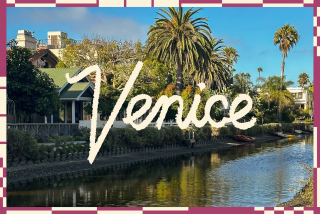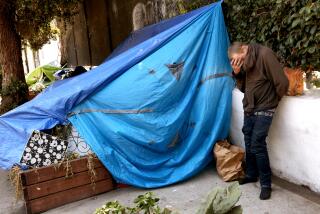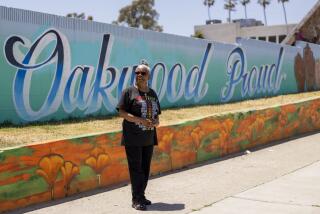Venice and Florence, 20 Years After Floods
VENICE, ITALY — Venice and Florence commemorate the 20th anniversary of their two separate floods (the cities are 160 miles apart) that caused devastation, and worldwide alarm, in November, 1966. The Florence “celebration”--in both places the local press use that word--has been a time for taking stock.
When the muddy waters of the Arno River broke through the high embankments, tanks of black oil fuel in the basements of museums and palaces burst, causing grievous damage to more than 1,500 paintings and more than 200 sculptures. There are still about 300 works awaiting restoration and several thousand antique books still caked with mud, but Florence looks better--and is better--than it was 20 years ago.
The urgency for digging out Florence caused hundreds of young people to descend on the city as volunteers--and those “mud angels” were remembered last week by the Florence mayor, Massimo Bogianckino. The city’s Ponte Vecchio, crossing the Arno since 1345, was one of the main reasons for embankments giving way upstream. Its spans were too low; debris soon turned the old bridge into a dam. The riverbed beneath the bridge now has been lowered and paved with smooth stones, meaning that the bridge and the embankments now can withstand the passage of 3,100 cubic meters of water a second--or 1,000 more than in 1966. The force of that flood, however, carried a little more than 4,000 cubic meters, so the city is not yet 100% secure.
In both Florence and Venice the positive effect of the floods, which here put St. Mark’s square under six feet of water, is upon the art. Works that might never have been cleaned, much less fully restored, are in the best condition since soon after they were created.
Yet the Venetian lagoon is in much worse shape today than in 1966. Nor has anything-- anything-- been done to prevent a similar flood, or “exception high water” as the Venetians call it. The lack of preventive measures against a flood may seem remarkable since the Rome government has given Venice what today would come to be $928 million to “safeguard” the city. The inaction is political; there is a common fear among the six main parties that one political party in charge would somehow also fill its own coffers in the distribution of the “save Venice” funds.
Premier Bettino Craxi came to join the Venice celebration. In a public speech, he admitted some delays but said work would start on mobile dams at the three mouths of the lagoon next year. These will be hollow iron cylinders, or perhaps sectional walls, about 64 feet wide, which can be filled with compressed air, causing them to rise from beds on the lagoon floor, forming a barrier between the Adriatic Sea and the lagoon. Satellite warnings can predict high water now, to the precise centimeter, as much as 48 hours ahead.
Some ecologists are wary of such tampering with the ebb and flow of tidal waters in the lagoon, because those movements have been carrying away Venice’s sewage for at least 1,500, and doing the job quite well. When Venice was still ruled by the Doges, the city’s small 107 internal canals had to be drained and cleaned of silt or refuse every 10 years. For the past 30 years, the city council has failed to do the job, except for one canal that was cleaned last year. Hydraulic experts who favor the three mobile dams even say that by opening one and closing the other two mouths, or vice versa, they can create a more “modern” and efficient flushing system.
Craxi also called for more low-income housing. In Venice, where nothing new can be built, this translates simply into making now-abandoned ground-floor apartments habitable. This is almost as urgent as the floodgates; younger couples have fled for lack of decent housing and there now are more Venetians over 60 than under 20.
Craxi’s speech did allude to the 10 foreign countries whose private citizens contributed funds and supervised restoration work in Venice since the flood. There are 30 foreign committees, some quite small, and all together they have raised at home--by garage sales, by masked balls, by persuasion--about $15 million.
Why did so many foreigners galvanize themselves to rescue Florence and Venice? Partly, it was great affection for two beautiful cities (one of them uncontestably unique for being built on water). Partly, it was appreciation for their great art. But several major world galleries have respectable samplings of some of the best Florentine and Venetian art. Educated people everywhere know that their debt to those two cities is greater than the beautiful things created there.
The Venetian Republic lasted more than 1,000 years without foreign invasion or internal rebellion. Its government worked, a world power for 600 years, greatly admired by America’s Founding Fathers. In the Venetian archives is a 1774 letter, signed by John Adams, Benjamin Franklin and Thomas Jefferson, saying that America wanted relations “with the most serene Republic of Venice.”
Florence had what some historians consider the first “modern” government; artisan guilds were given a role in governing even when a dictator was momentarily in charge. Our debt to the Florentines, however, is larger still: They gave birth to the Renaissance, coaxing the world out of the Dark Ages, allowing the ideas and ideals of Athens and ancient Rome to be reborn. The individual again found dignity.
Venice’s authorities have mounted a small exhibit of before-and-after photographs showing some of the completed restoration work. The exhibit brochure selects eight art works to illustrate the stupendous achievements but fails to note that four of them were done wholly or partly by foreign committees. England’s Venice in Peril Fund, for example, was fully responsible for restoring the stone portal of the Doge’s palace and largely responsible for the magnificent work done to Torcello’s 12th-Century mosaics. The outside, spiral staircase of the Contarini-Bovolo palace is in better condition than it has been for several centuries--all paid for by the good people of Minnesota. These facts are not spelled out by local authorities. A pity; the current commemorative celebration would have been a fine time for saying “thanks.”
Craxi also offered his imprimatur to the crackpot idea of some local Venice Socialists--to hold a 1997 world’s fair, or an “Expo Universale,” in the city. Promoters of the fair already predict that it would draw more people than the 20 million who went to Vancouver’s Expo.
Every Venetian, and any visitor, knows that from Palm Sunday to Halloween, there are too many tourists for comfort or capacity. Last Easter, after an estimated 100,000 outsiders (most of them Italian) had crossed the causeway linking Venice to the mainland, the entry was ordered shut. Venice’s previous mayor, Mario Riga, has been saying for years that a quota for visitors must be established throughout the year.
Venice is a group of mostly man-made islands and islets, tacked together by bridges. Its great stone palaces and churches are built on wooden pilings, in the middle of the lagoon. It is fragile. If Venice is to be sunk forever, let it be by an act of uncontrollable nature, not by the weight of a million marching human feet on their way to a fair--a fair that would commemorate the fall of the Venetian Republic, which bowed before Napoleon Bonaparte’s powerful, looting troops in 1797. Has any once-great nation ever celebrated the death of its own freedom?
More to Read
Sign up for Essential California
The most important California stories and recommendations in your inbox every morning.
You may occasionally receive promotional content from the Los Angeles Times.










